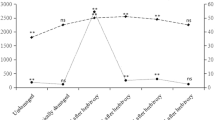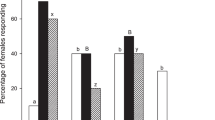Summary
Undamaged plants emit low levels of green leaf volatiles (GLVs), while caterpillar-damaged and artificially damaged plants emit relatively higher levels of certain GLVs. Female braconid parasitoids,Microplitis croceipes, oriented to both damaged plants and to individual GLVs in no-choice tests in a wind tunnel, but seldom oriented to undamaged plants. Female ichneumonid parasitoids,Netelia heroica, also oriented to individual GLVs in a wind tunnel. Males of both wasp species failed to orient to the GLVs. These data show that leaf-feeding caterpillars can cause the release of GLVs, and that parasitic wasps can respond to these odors by flying upwind (chemoanemotactic response), which brings the wasps to their caterpillar hosts. This supports the hypothesis that plants communicate with members of the third trophic level,i.e., plants under herbivore attack emit chemical signals that guide natural enemies of herbivores to sites of plant damage. In this interaction, the GLVs serve as tritrophic plant-to-parasitoid synomones. That parasitoids from two different wasp families oriented to GLVs suggests that the response may be widespread among the Hymenoptera.
Similar content being viewed by others
References
Aldrich JR, Kochansky JP, Sexton JD (1985) Chemical attraction of the eastern yellowjacket,Vespula maculifrons (Hymenoptera: Vespidae). Experientia 41:420–422
Aldrich JR, Lusby WR, Kochansky JP (1986) Identification of a new predaceous stink bug pheromone and its attractiveness to the eastern yellowjacket. Experientia 42:583–585
Baehrecke EH, Williams HJ, Vinson SB (1989) Electroantennogram responses ofCampoletis sonorensis (Hymenoptera: Ichneumonidae) to chemicals in cotton. J Chem Ecol 15:37–45
Blum MS (1976) Pheromonal communication in social and semisocial insects. Pp 49–60in Kono T & Ishii S (eds) Proceedings of a Symposium on Insect Pheromones and their Applications. Kasumigaseki, Japan: Ministry Agric Forestry
Burton RL (1969) Mass rearing the corn earworm in the laboratory. U.S. Dept Agric Tech Bull ARS Ser 33–134:1–8
Buttery RG, Xu C-J, Ling LC (1985) Volatile components of wheat leaves (and stems): possible insect attractants. J Agric Food Chem 33:115–117
Cardé RT, Lee H (1989) Effect of experience on the responses of the parasitoidBrachymeria intermedia (Hymenoptera: Chalcididae) to its host,Lymantria dispar (Lepidoptera: Lymantriidae), and to kairomone. Ann Entomol Soc Am 82:653–657
Crewe RM, Blum MS, Collingwood CA (1972) Comparative analysis of alarm pheromones in the ant genusCrematogaster. Comp Biochem Physiol 43B:703–716
Dicke M, Sabelis MW (1988) How plants obtain predatory mites as body-guards. Netherlands J Zool 38:148–165
Dicke M, Sabelis MW (1989) Does it pay plants to advertise for body-guards? Toward a cost-benefit analysis of induced synomone production. Pp 341–358in Lambers H, Cambridge ML, Konings H & Pons TL (eds) Causes and Consequences of Variation in Growth Rate and Productivity of Higher Plants. The Hague: SPB Academic Publishing
Dicke M, Van Beek TA, Posthumus MA, Ben Dom N, Van Bokhoven H, De Groot AE (1990) Isolation and identification of volatile kairomone that affects acarine predator-prey interactions involvement of host plant in its production. J Chem Ecol 16:381–396
Dickens JC (1989) Green leaf volatiles enhance aggregation pheromone of boll weevil,Anthonomous grandis. Entomol exp appl 52:191–203
Dickens JC, Jang EB, Light DM, Alford AR (1990) Enhancement of insect pheromone response by green leaf volatiles. Naturwissenschaften 77:29–31
Ding D, Swedenborg PD, Jones RL (1989) Chemical stimuli in hostseeking behavior ofMacrocentrus grandii (Hymenoptera: Braconidae). Ann Entomol Soc Am 82:232–236
Drost YC, Lewis WJ, Zanen PO, Keller MA (1986) Beneficial Arthropod behavior mediated by airborne semiochemicals. I. Flight behavior and influence of preflight handling ofMicroplitis croceipes (Cresson). J Chem Ecol 12:1247–1262
Drost YC, Lewis WJ, Tumlinson JH (1988) Beneficial arthropod behavior mediated by airborne semiochemicals. V. Influence of rearing method, host plant, and adult experience on host-searching behavior ofMicroplitis croceipes (Cresson), a larval parasitoid ofHeliothis. J Chem Ecol 14:1607–1616
Edwards PB, Wanjura WJ (1989) Eucalypt-feeding insects bite off more than they can chew: sabotage of induced defences? Oikos 54:246–248
Eller FJ, Tumlinson JH, Lewis WJ (1988a) Beneficial arthropod behavior mediated by airborne semiochemicals. II. Olfactometric studies of host location by the parasitoidMicroplitis croceipes (Cresson) (Hymenoptera: Braconidae). J Chem Ecol 14:425–434
Eller FJ, Tumlinson JH, Lewis WJ (1988b) Beneficial arthropod behavior mediated by airborne semiochemicals: source of volatiles mediating the host-location flight behavior ofMicroplitis croceipes (Cresson) (Hymenoptera: Braconidae), a parasitoid ofHeliothis zea (Boddie) (Lepidoptera: Noctuidae). Environ Entomol 17:745–753
Elzen GW, Williams HJ, Vinson SB (1983) Response by the parasitoidCampoletis sonorensis (Hymenoptera: Ichneumonidae) to chemicals (synomones) in plants: implications for host habitat location. Environ Entomol 12:1872–1876
Gauld ID (1988) Evolutionary patterns of host utilization by ichneumonoid parasitoids (Hymenoptera: Ichneumonidae and Braconidae). Biol J Linn Soc 35:351–377
Hamilton-Kemp TR, Andersen RA, Rodriguez JG, Loughrin JH, Patterson CG (1988) Strawberry foliage headspace vapor components at periods of susceptibility and resistance toTetranychus urticae Koch. J Chem Ecol 14:789–796
Hamilton-Kemp TR, Rodriguez JG, Archbold DD, Andersen RA, Loughrin JH, Patterson CG, Lowry SR (1989) Strawberry resistance toTetranychus urticae Koch: effects of flower, fruit, and foliage removal-comparisons of air-vs nitrogen-entrained volatile compounds. J Chem Ecol 15:1465–1473
Hedin PA, Thompson AC, Gueldner RC (1973) The boll weevil-cotton plant complex. Toxicol Environ Chem Rev 1:291–351
Hedin PA, Thompson AC, Gueldner RC (1975) Survey of air space volatiles of the cotton plant. Phytochemistry 14:2088–2090
Heinrich B (1979) Foraging strategies of caterpillars leaf damage and possible predator avoidance strategies. Oecologia 42:325–337
Heinrich B, Collins SL (1983) Caterpillar leaf damage, and the game of hide-and-seek with birds. Ecology 64:592–602
Hérard F, Keller MA, Lewis WJ, Tumlinson JH (1988a) Beneficial arthropod behavior mediated by airborne semiochemicals. III. Influence of age and experience on flight chamber responses ofMicroplitis demolitor Wilkinson. J Chem Ecol 14:1583–1596
Hérard F, Keller MA, Lewis WJ, Tumlinson JH (1988b) Beneficial arthropod behavior mediated by airborne semiochemicals. IV. Influence of host diet on host-oriented flight chamber responses ofMicroplitis demolitor Wilkinson. J Chem Ecol 15:1597–1606
Hernandez HP, Hsieh TC-Y, Smith CM, Fischer NH (1989) Foliage volatiles of two rice cultivars. Phytochemistry 28:2959–2962
Johnson SJ, King EG, Bradley JR Jr (eds) (1986) Theory and tactics ofHeliothis population management: I. Cultural and biological control. Southern Coop Ser Bull 316
Kamm JA, Buttery RG (1983) Response of the alfalfa seed chalcid,Bruchophagus roddi, to alfalfa volatiles. Entomol exp appl 33:129–134
Lederhouse RC (1990) Avoiding the hunt: primary defenses of lepidopteran caterpillars. Pp 175–189in Evans D & Schmidt J (eds) Insect Defenses. Albany, New York: State University of New York Press
Lewis WJ, Burton RL (1970) RearingMicroplitis croceipes in the laboratory withHeliothis zea as hosts. J Econ Entomol 63:656–658
Lewis WJ, Jones RL (1971) Substance that stimulates host-seeking byMicroplitis croceipes (Hymenoptera: Braconidae), a parasite ofHeliothis species. Ann Entomol Soc Am 64:471–473
Lewis WJ, Tumlinson JH (1988) Host detection by chemically mediated associative learning in a parasitic wasp. Nature 331:257–259
Liu S-H, Norris DM, Marti E (1988) Behavioral responses of female adultTrichoplusia ni to volatiles from soybeansversus a preferred host, lima bean. Entomol exp appl 49:99–109
Loke WH, Ashley TR, Sailer RI (1983) Influence of fall armyworm,Spodoptera frugiperda (Lepidoptera: Noctuidae), larvae and corn plant damage on host finding inApanteles marginiventris (Hymenoptera: Braconidae). Environ Entomol 12:911–915
Lwande W, McDowell PG, Amiani H, Amoke P (1989) Analysis of airborne volatiles of cowpea. Phytochemistry 28:421–423
Martin WR Jr, Nordlund DA, Nettles WC Jr (1990) Response of parasitoidEucelatoria bryani to selected plant material in an olfactometer. J Chem Ecol 16:499–508
Mitchell BK (1988) Adult leaf beetles as models for exploring the chemical basis of host-plant recognition. J Insect Physiol 34:213–225
Nadel H, van Alphen JJM (1987) The role of host- and host-plant odours in the attraction of a parasitoid,Epidinocarsis lopezi, to the habitat of its host, the cassava mealybug,Phenacoccus manihoti. Entomol exp appl 45:181–186
Navasero RC, Elzen GW (1989) Responses ofMicroplitis croceipes to host and nonhost plants ofHeliothis virescens in a wind tunnel. Entomol exp appl 53:57–63
Nordlund DA, Lewis WJ, Altieri MA (1988) Influences of plant-produced allelochemicals on the host/prey selection behavior of entomophagous insects. Pp 65–90in Barbosa P & Letourneau D (eds) Novel Aspects of Insect-Plant Interactions. New York: John Wiley
Odell TM, Godwin PA (1984) Host selection byBlepharipa pratensis (Meigen), a tachinid parasite of the gypsy moth,Lymantria dispar L. J Chem Ecol 10:311–320
Powell JE, Bull DL, King EG (1989) Biological control ofHeliothis spp. byMicroplitis croceipes. Southwestern Entomol Suppl 12:1–115
Saijo R, Takeo T (1975) Increase ofcis-3-hexen-1-ol content in tea leaves following mechanical injury. Phytochemistry 14:181–182
Sato Y (1979) Experimental studies on parasitization byApanteles glomeratus. IV. Factors leading a female to the host. Physiol Entomol 4:63–70
Sheehan W, Shelton AM (1989) The role experience in plant foraging by the aphid parasitoidDiaeretiella rapae (Hymenoptera: Aphidiidae). J Insect Behav 2:743–759
Sugimoto T, Kameoka H, Kusatani S, Invi O, Otsuka K (1988) Foraging for patchily-distributed leaf-miners by the parasitoid,Dapsilarthra rufiventris (Hymenoptera: Braconidae) V. Plant odour as a cue to long range patch-location. Appl Entomol Zool 23:135–143
Thiery D, Bluet JM, Pham-Delègue M-H, Etiévant P, Masson C (1990) Sunflower aroma detection by the honeybee: study by coupling gas chromatography and electroantennography. J Chem Ecol 16:701–711
Thompson AC, Baker DN, Gueldner RC, Hedin PA (1971) Identification and quantitative analysis of the volatile substances emitted by maturing cotton in the field. Plant Physiol 48:50–52
Tollsten L, Bergström G (1988) Headspace volatiles of whole plants and macerated plant parts ofBrassica sinapis. Phytochemistry 27:4013–4018
Townes HK (1939) The Nearctic species ofNetelia (Paniscus of Authors) and a revision of the genera of Neteliini (Hymenoptera, Ichneumonidae) Lloydia 1:168–231
Veith HJ (1984) 2-Methyl-3-butene-2-ol, a major component of the alarm pheromone of the hornetVespa crabro. Naturwissenschaften 71:328
Vet LEM, van Opzeeland K (1985) Olfactory microhabitat selection inLeptopilina heterotoma (Thomson) (Hym.: Eucoilidae), a parasitoid of drosophilidae. Neth J Zool 35:497–504
Vinson SB (1984) Parasite-host relationships. Pp 205–233in Bell WJ & Cardé RT (eds) Chemical Ecology of Insects. London: Chapman and Hall
Visser JH (1983) Differential sensory perceptions of plant compounds by insects. Pp 215–230in Hedin PA (ed) Plant Resistance to Insects. ASC Symposium Series 208. Washington, D.C.: American Chemical Society
Visser JH (1986) Host odor perception in phytophagous insects. Annu Rev Entomol 31:121–144
Visser JH, Avé DA (1978) General green leaf volatiles in the olfactory orientation of the Colorado beetle,Leptinotarsa decemlineata. Entomol exp appl 24:538–549
Visser JH, Van Straten S, Maarse H (1979) Isolation and identification of volatiles in the foliage of potato,Solanum tuberosum, a host plant of the colorado beetle,Leptinotarsa decemlineata. J Chem Ecol 5:13–25
Wallbank BE, Wheatley GA (1976) Volatile constituents from cauliflower and other crucifers. Phytochemistry 15:763–766
Whitman DW (1988a) Plant natural products as parasitoid cuing agents. Pp 386–396in Cuttler HG (ed) Biologically Active Natural Products Potential use in Agriculture. ASC Symp Ser 380. Washington D.C.: American Chemical Society
Whitman DW (1988b) Allelochemical interactions among plants, herbivores, and their predators. Pp 11–64in Barbosa P & Letourneau D (eds) Novel Aspects of Insect-Plant Interactions. New York: John Wiley
Author information
Authors and Affiliations
Additional information
Mention of a commercial or proprietary product does not constitute an endorsement by the U.S. Department of Agriculture
Rights and permissions
About this article
Cite this article
Whitman, D.W., Eller, F.J. Parasitic wasps orient to green leaf volatiles. Chemoecology 1, 69–76 (1990). https://doi.org/10.1007/BF01325231
Received:
Accepted:
Issue Date:
DOI: https://doi.org/10.1007/BF01325231




